
Instituto Amazónico de Investigaciones Científicas - SINCHI
Leticia, Colombia
https://doi.org/10.21068/c2020.v21n02a07
José Rancés Caicedo Portilla 
Instituto Amazónico de Investigaciones Científicas - SINCHI
Leticia, Colombia
Doris L. Gutiérrez Lamus 
Instituto Amazónico de Investigaciones Científicas - SINCHI
Bogotá, Colombia
Recibido: 21 de febrero 2020
Aceptado: 14 de mayo 2020
We documented the easternmost records in Colombia of the lizard Gonatodes albogularis, and we hypothesize that these records correspond to introductions, since the specimens have always been collected in anthropogenic habitats. We are not certain that the historical records of the eastern slope of the Cordillera Oriental correspond to accidental introductions (transplanted species) or if they are actually the historical distribution of the species. We consider that G. albogularis is a species that will continue to disperse in the Amazon and Orinoco regions. Population studies should be carried out using molecular tools (haplotypes) in order to elucidate the origin of the cis-Andean populations of this species in the country. We report the second specimen with leucism in Colombia.
Keywords. Amazonia. Geographical distribution. Inírida. Mitú. Transplanted species, Yellow-headed Gecko.
Documentamos los registros más al oriente del lagarto Gonatodes albogularis en Colombia, sospechamos que estas corresponden a introducciones, ya que los ejemplares se han recolectado siempre en hábitats antrópicos. No tenemos certeza de que los registros históricos de la vertiente oriental de la Cordillera Oriental corresponden a introducciones accidentales (especie trasplantada) o si, por el contrario, son en realidad la distribución histórica de la especie. Consideramos que G. albogularis es una especie que va a seguir dispersándose en las regiones de la Amazonia y la Orinoquia. Se deben realizar estudios poblacionales por medio de herramientas moleculares (haplotipos) para poder dilucidar el origen de las poblaciones cisandinas de esta especie en el país. Reportamos el segundo ejemplar con leucismo en Colombia.
Palabras clave. Amazonia. Distribución geográfica. Geco de cabeza amarilla. Especie trasplantada. Inírida. Mitú.
The genus Gonatodes contains 33 species (Uetz et al., 2019; Meneses-Pelayo & Ramírez, 2020; Rivero-Blanco & Schargel, 2020) of which only five have been reported to Colombia: Gonatodes albogularis, Gonatodes chucuri, G. humeralis, G. riveroi, and G. vittatus (Ayala, 1986; Sturaro & Avila Pires, 2011; Meneses-Pelayo & Ramírez, 2020). Gonatodes albogularis is a small lizard with a wide distribution. It is found in Central America, the Caribbean Islands, and northern South America, in Colombia and Venezuela (Peters & Donoso-Barros, 1970; Savage, 2002; Köhler, 2008). In Colombia, G. albogularis occurs in the Trans-Andean lowlands and in the lowlands of the eastern slopes of the Cordillera Oriental (Ayala, 1986, Sánchez et al., 1995). This small diurnal lizard lives in a wide variety of habitats, from humid tropical forests to dry tropical forests, between 0-1500 m a.s.l (Peters & Donoso-Barros, 1970). The species is frequently observed in disturbed areas, where it prefers human buildings (Rivero-Blanco, 1968; Serrano-Cardozo et al., 2007). It was introduced in Florida, USA (Krysko, 2005), San Andrés and Providence islands in Colombia (Forero-Medina et al., 2006; pers. obs. JRCP), apparently in Belize (Lee, 2000 in Jablonski, 2015), and Venezuela's Orinoco River delta (Rivas-Fuenmayor & Molina, 2003). Herein we document new cis-Andean records of distribution of the Yellow-Headed Gecko in Colombia, and report the second specimen with leucism in this country.
The field work in different locations in the Colombian Amazon was funded and conducted by the Sinchi Institute. We searched for herps during the day and at night using visual encounter surveys (VES). The animals were caught by hand, kept in a bag, euthanized with an overdose of 2% Roxicaine, fixed in 10% formalin, and finally preserved in 70% ethanol. The specimens are deposited in the reptile collection of Instituto Sinchi (SINCHI-R), located in the city of Leticia, in the Amazonas department.
The specimens were taxonomically identified by external characteristics, such as: eyelids absent; round pupil, antehumeral white bar (vs. a conspicuous white suprahumeral bar or spot with black margins within the G. concinnatus complex); lamellae under digits not flattened, and not wider than the digits (vs. subdigital scales flattened, often wider than the tip of the toe in G. humeralis); and the coloration pattern of males, which is characteristic for most of the species in the genus Gonatodes (Peters & Donoso-Barros, 1970; Avila-Pires, 1995; Savage, 2002; Sturaro & Avila-Pires , 2011), except in G. lichenosus and G. chucuri, which do not have sexual dichromatism (Rojas-Runjaic et al., 2010; Meneses-Pelayo & Ramírez, 2020).
A map was created using presence locations of G. albogularis as recorded in the literature and information compiled after visiting several biological collections including Instituto de Ciencias Naturales (ICN), La Salle Museum of Natural History (MLS) and Instituto Alexander von Humboldt (IAvH).
On July 6, 2015 one female (SINCHI-R-388) and a male (SINCHI-R-389; Figure 1A) were captured on the back walls of a hotel in Inírida city, Guainía. (Table 1, Figure 2); later, on November 15th and 16th of 2015, in the same locality, we found a gecko, which at first glance was similar to one of the species of Hemidactylus (H. palaichthus and H. frenatus), which are commonly found in the city. However, after carefully examining the specimen, we were able to confirm that it belonged to a lightly colored female of G. albogularis (SINCHI- R- 538; figure 1B). The specimen was found in the same hotel under the stairs, which were made of cement and covered with white paint.
In life, the specimen SINCHI-R-538 was dorsally beige with fine reddish-brown dots; iris light brown with a beige internal ring; tail and extremities light yellow, white throat, and a yellowish venter. In alcohol, this specimen is dorsally whitish with tiny brown spots; one thin white antehumeral bar; white flanks with small pale brown spots; its regenerated tail is white; venter white with tiny grey dots, which are more visible on the ventral surface of the extremities. Due to the pattern of abnormal coloration, this specimen clearly presents a condition of leucism.
Two more females of G. albogularis were collected in the same hotel (SINCHI- R- 541 and SINCHI-R-542), both of which were cryptically colored. In life, SINCHI-R- 541 was dorsally grey brown with dark brown spots and beige dots, and ventrally it was dark yellow. SINCHI-R-542 had a similar coloration to SINCHI-R-541, but also had white dots forming transversal lines on flanks and on the back (Figure 1C). When preserved in alcohol, all normally colored specimens of G. albogularis show a paler coloration than alive, but they never exhibit a whitish color.
Table 1. Cis-Andean collections of Gonatodes albogularis in Colombia. Each site is represented on the distribution map in Figure 2.
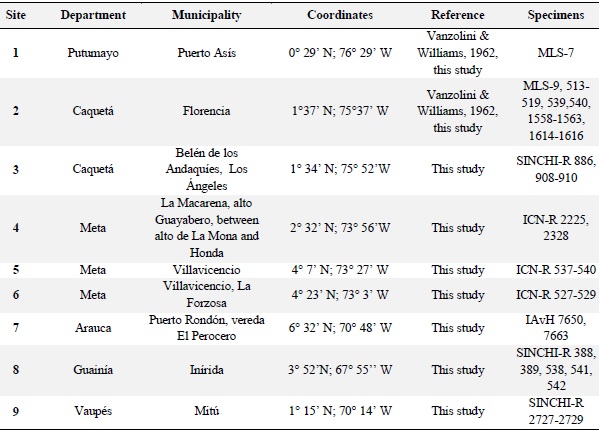
a. 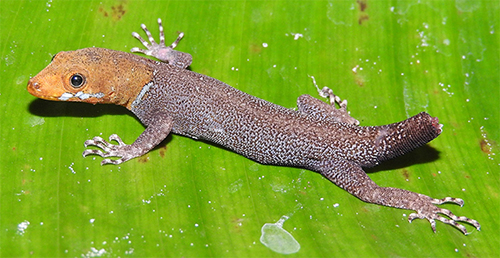
b. 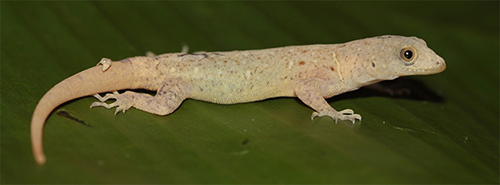
c.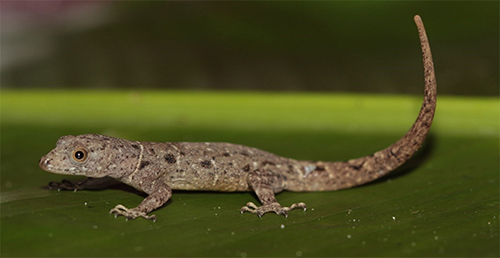
Figure 1. Gonatodes albogularis. A, male specimen (SINCHI-R-389); B, female specimen with leucism (SINCHI-R-538); C, female with normal coloration (SINCHI-R-541). The three specimens are from Inírida, eastern Colombia.
On January 22nd and 23rd of 2017, four females were caught (SINCHI-R 886, 908-910) in Los Angeles, a village at Belén de los Andaquíes, Caquetá (Table 1, Figure 2). The specimens were captured at night, on the roofs of the houses, while they were actively foraging next to Hemidactylus angulatus. At the same locality, a male with a yellowish head and blue spots on his lips was observed, but escaped when attempting to capture it.
On July 15th of 2018, two males (SINCHI-R-2727 and 2728) and one female (SINCHI-R-2729) were captured in the city of Mitú, Vaupés (Table 1, Figure 2). The specimens were captured at approximately 8:00 hours, when they were basking and foraging on a wooden fence, next to the headquarters of Sinchi Institute in that locality. Juveniles of this species were observed as well.
Cis-Andean records from the departments of Arauca, Meta, Caquetá, and Putumayo (Table 1, Figure 2) were found after checking Ayala (1986), Vanzolini & Williams (1962); there are specimens from the city of Florencia (Caquetá), deposited in the herpetological collection of La Salle Museum of Natural History (MLS 513-519, MLS-13, MLS 539-540). Specimens from Arauca and Meta are deposited in Instituto Alexander von Humboldt (IAvH) and Instituto de Ciencias Naturales (ICN), respectively (Table 1).
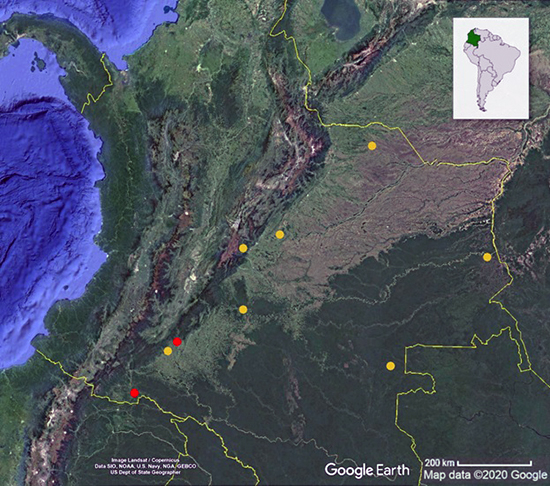
Figure 2. Cis-Andean distribution of Gonatodes albogularis in Colombia, showing previously known (red circles) and new records (yellow circles). Datum: WGS84.
The specimen SINCHI-R 538 is the second individual of G. albogularis with leucism reported in Colombia; the first case was reported by Grisales-Martínez & Arias-Álvarez (2018) for a female collected in the trans-Andean department of Antioquia. Interestingly, the specimen collected by us was found on a background with white color, which was ideal for the individual to blend in with the environment. Animals with pigment abnormalities have a lower survival rate, caused by a higher detectability to predators, and problems associated with thermoregulation due to a lesser ability to gain calories from solar radiation (Rivera et al., 2001).
The first cis-Andean voucher of Gonatodes albogularis was collected in November 1936 (MLS-7), in the municipality of Puerto Asís, Putumayo; this specimen was reported by Ayala (1986), without an accurate date or location; seemingly this specimen was recorded on a map made by Vanzolini & Williams (1962), but it was not referenced in their list of examined specimens. There are specimens deposited in the ICN reptile collection that were collected between 1943-1944 by the American herpetologist E. R. Dunn in or around the city of Villavicencio, as well as the specimens deposited in the herpetological collection of the Museum of Natural History of La Salle (MLS), which were collected in 1951, presumably by Brother Nicéforo María in the city of Florencia, Caquetá (Berrio-Martínez et al., 2011).
The cities of Mitú and Inírida are isolated by land from the rest of the country. The connections of these cities with other locations are made by waterway through the Vaupés and Guaviare River, respectively, or by air, mainly from Bogotá and Villavicencio, the latter city with records of the Yellow-headed gecko mentioned above (Pers. obs.). The specimens from these cities confirm an eastward range extension of G. albogularis in Colombia. Our findings in Inírida represent a range extension to ca. 441 km in a straight line; and Mitú records are approximately 435 km away from the location between the Duda River and the Serranía de la Macarena, Meta. Likewise, there are no close records of the species in at least 400 km around the localities reported in the present work.
We are not sure if the specimens of the eastern slopes of the Cordillera Oriental were accidental or intentional introductions, or whether they are part of the historical distribution of the species. For this reason, it is advisable to carry out population studies using morphological evidence and molecular methods (haplotypes) with samples from the entire range of distribution of the species in order to confirm whether the populations from the eastern flank of the Cordillera Oriental are natural populations (native) of the species or transplanted ones.
On the other hand, we consider it possible that G. albogularis has been transplanted to the east of the country due to the records presented on this work, all of them are associated with human constructions and there are not known records nor evidence of their existence within natural habitats, at least from what we have sampled along the departments of Guainía, Vaupés, and Caquetá. Something similar has been reported for Gonatodes caudiscutatus from the Upper Amazon Basin, which has been reported on the eastern flank of the Andes in Ecuador (Carvajal-Campos & Torres-Carvajal, 2012).
Other species of the genus Gonatodes have been recorded outside of their natural distribution area. For instance, G. vittatus has been recorded in Guyana (Meilink et al., 2013) and G. caudiscutatus, known from the Pacific coast of Ecuador, it has been registered on Chatham island (San Cristóbal), one of the Galápagos islands (Carvajal-Campos & Torres-Carvajal, 2012; Sturaro & Avila-Pires, 2013); it seems like lizards of the genus Gonatodes are very mobile, presumably using human transport.
Gonatodes albogularis seems to be one of the most colonizing species within the genus, since it has arrived and established itself in different locations outside its natural area of distribution (Rivero-Blanco, 1968; Rivas-Fuenmayor & Molina, 2003; Krysko, 2005; Forero-Medina et al., 2006; Lee, 2000 in Jablonski, 2015). For those reasons, and the new records presented here, it is highly probable that G. albogularis will continue spreading throughout the cis-Andean region of Colombia.
We thank Germán C. Martínez for his assistance with the distribution map, Andrés Barona for his comments on the manuscript, and the reviewers and editors for their helpful suggestions.
Avila-Pires, T.C.S. (1995). Lizards of Brazilian Amazonia (Reptilia: Squamata). Zoologische Verhandelingen, 299, 1–706.
Ayala, S.C. (1986). Saurios de Colombia: lista actualizada, y distribución de ejemplares colombianos en los museos. Caldasia, 15(71-75), 555-575.
Berrío Martínez, J., Vásquez Valencia, M.F., Estrada Orrego, V. (2011). El hermano Nicéforo María: un naturalista consagrado y la red de Museos de La Salle. En Jímenez Gómez, S. I. (Ed.). Museo de historia natural Colegio de San José. Patrimonio científico e histórico. Colección Bicentenario de Antioquia. Pp. 49-59. Medellín, Colombia: Cadena S.A.
Carvajal-Campos, A. & Torres-Carvajal, O. (2012). Gonatodes caudiscutatus (Günther, 1859) (Squamata: Sphaerodactylidae): Distribution Extension in Ecuador. Check List, 8(3), 525-527.
https://doi.org/10.15560/8.3.525
Forero-Medina, G., Castaño-Mora O. V. & Rodríguez-Melo, M. (2006). Ecología de Caiman crocodilus fuscus en San Andrés Isla, Colombia: un estudio preliminar. Caldasia, 28(1), 115-124.
Grisales-Martínez, F. A. & Arias-Álvarez, L. (2018). Leucism in the Yellow-Headed Gecko (Duméril & Bibron, 1836). Herpetology Notes, 11, 1003-1005.
Jablonski, D. (2015). Gonatodes albogularis: communal egg laying. Mesoamerican Herpetology, 2(2), 195-196.
Köhler, G. K. (2008). Reptiles of Central America. 2nd Edition. Offenbach, Germany: Herpeton Verlag Elke Kohler.
Krysko, K. L. (2005). Ecological status of the introduced yellow headed gecko, Gonatodes albogularis (Sauria: Gekkonidae), in Florida. Florida Scientist Biological Sciences, 68, 272-280.
Meilink, W. R. M., Clegg, J. R., Mayerl, C. J., Pinto, J. S., Grasso, D., Stejen, G., Segal, M. & Kok, P. J. R. (2013). Confirmation of the presence of the sphaerodactylid lizard Gonatodes vittatus in Guyana, and an indication of a reproductively active population in Georgetown. Salamandra, 49(1), 59-62.
Meneses-Pelayo, E. & Ramírez, J. P. (2020). A new species of the genus Gonatodes (Squamata: Sauria: Sphaerodactylidae) from the western flank of the Cordillera Oriental in Colombia, with description of its hemipenial morphology. Zootaxa, 4729(2), 207–227.
https://doi.org/10.11646/zootaxa.4729.2.4
Peters, J. & Donoso-Barros, R. (1970). Catalogue of the Neotropical Squamata. Part II. Lizard and Amphisbaenians. United States National Museum Bulletin, 297, 1-293. Washington D.C.: Smithsonian Institution Press.
https://doi.org/10.5479/si.03629236.297.1
Rivas-Fuenmayor, G. & Molina, C. R. (2003). New records of reptiles from the Orinoco Delta, Amacuro State, Venezuela. Herpetological Review, 34(2), 171-173.
Rivera, X., Arribas, O & Martí, F. (2001). Anomalías pigmentarias en las especies de reptiles presentes en la Península Ibérica, Islas Baleares y Canarias. Butlletí de la Societat Catalana d’Herpetologia, 15, 76-88.
Rivero-Blanco, C. (1968). Un género y dos especies de tuqueques (Sauria: Sphaerodactylinae) citados por primera vez para Venezuela, con notas sobre la distribución de otras especies poco conocidas. Memoria de la Sociedad de Ciencias Naturales la Salle, 27(77), 103-119.
Rivero-Blanco, C. & Schargel, W. E. (2020). A new diurnal gecko in the genus Gonatodes (Squamata: Sphaerodactylidae) from Margarita Island, Venezuela. Zootaxa, 4729(3), 429–439.
https://doi.org/10.11646/zootaxa.4729.3.9
Rojas-Runjaic, F. J. M., Infante-Rivero, E. E., Cabello, P. & Velozo, P. (2010). A new non-sexually dichromatic species of the genus Gonatodes (Sauria: Sphaerodactylidae) from Sierra de Perijá, Venezuela. Zootaxa, 2671, 1–16.
https://doi.org/10.11646/zootaxa.2919.1.2
Sánchez-C, H., Castaño-M., O. & Cárdenas-A., G. (1995). Diversidad de los reptiles en Colombia. In: Rangel-Ch., J. O. (ed.). Colombia Diversidad Biótica I. pp. 277-325. Santa Fe de Bogotá D. C.: Instituto de Ciencias Naturales-Universidad Nacional de Colombia-INDERENA.
Savage, J. M. (2002). The amphibians and reptiles of Costa Rica: a herpetofauna between two continents, between two seas. Chicago, USA: University of Chicago Press.
Serrano-Cardozo, V. H., Ramírez-Pinilla, M. P., Ortega, J. E. & Cortés, L. A. (2007). Annual reproductive activity of Gonatodes albogularis (Squamata: Gekkonidae) living in an anthropic area in Santander, Colombia. South American Journal of Herpetology, 2(1), 31-38.
Sturaro, M.J., Avila-Pires, T.C.S. (2011). Taxonomic revision of the geckos of the Gonatodes concinnatus complex (Squamata: Sphaerodactylidae), with description of two new species. Zootaxa, 2869, 1-36.
https://doi.org/10.11646/zootaxa.2869.1.1
Sturaro, M. J. & Avila-Pires, T. C. S. (2013). Redescription of the gecko Gonatodes caudiscutatus (Günther, 1859) (Squamata: Sphaerodactylidae). South American Journal of Herpetology, 8(2), 132-145.
https://doi.org/10.2994/SAJH-D-13-00002.1
Uetz, P., Freed, P. & Hošek, J. (Eds.) (2019). The reptile Database, http://www.reptile-database.org accessed (June/2019).
Vanzolini, P. E. & Williams, E. E. (1962). Jamaican and Hispaniolan Gonatodes and allied forms (Sauria, Gekkonidae). Bulletin of the Museum of Comparative Zoology, 127(10), 479-498.